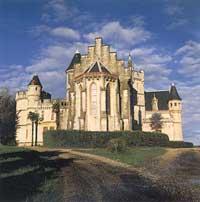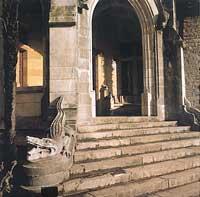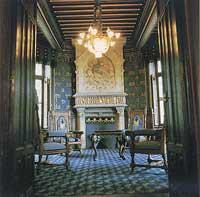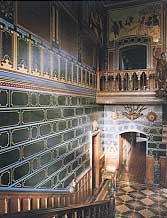I know, instead of pretending
As it approaches, the contrast between the thick grey stone outside the house decorated with strange sculptures and the bright interior decoration of the polychrome is even more surprising.

Another of the most remarkable contrasts is that of theater decoration and the humility of most rooms: in the dining room enter a dozen guests, do not enter much more in the room and there are few guest rooms.
The questions immediately arise: who wanted this rich decoration and why?
Abbadia Castle is a new building. The distribution of the foot and the interior decoration could be done with total freedom. It has not been necessary to limit oneself to the buildings already built or to adjust to the limits that mark the reforms. The choice of decoration was made by a threesome:
- First owners: Sres. Abbadia. They are due to the choice of most iconographic trends, the purchase of furniture and, above all, the use of expressions written in fourteen languages. These sayings make the castle a unique dictionary.
- Edmund Duthoit, architect decorator, was assistant to Viollet le Duc in Roquetaillade. He showed a delicate sensitivity to exotic or strange subjects, his experience as a traveler and archaeologist in the Arab countries of North and East Africa, allowed him to be very dressed in these subjects.
- Viollet le Duc, the last architect who worked in the castle. He was responsible for the selection of volumes, the lighting of the classrooms and especially the creation of “atmosphere”.

They had a very close relationship. Antoine Abbadia's letters bear witness to this. Comprehensive control of construction sites. Many details for the furniture were drawn by Duthoit himself. Handmade drawings have been found for the silver ornaments of the chapel. The finishing quality of the Moro cabinet, domed ornaments, ceramic and carved wood coatings and paintings show the wide knowledge this architect had of Eastern cultures.
Monumental construction that Viollet le Duc himself wanted to do polychrome. Despite being almost overloaded, the accumulation of decorations and colors creates a unified environment and no cocoa is produced. In Abbadia, as in Roquetaillade, it is observed that bold theories have been used about the color that Viollet le Duc defined in his Dictionary of Architecture.
In the entrance hall, for example, the color has been put at the service of the architecture; on the ground floor the black, the red ponpeon to separate the plant and in the high partitions the almond green. The landscapes are surrounded by a lively blue edge or playing with stone works, climbing the walls and highlighting the arch of the doors. Each table and board is embroidered by numerous colored lines and is surrounded by friezes of geometry or regular bouquet of flowers and fruits.
But Antoine Abbadia is truly responsible for the surprise that is generated to all visitors from the entrance door of the farm. With the construction of this castle, in which he spent almost all year, he wanted to offer a collection of all his travels, his thoughts and discoveries. First of all, he wants to be an indicator of his social level: he is a new Spanish. And this 360 ha farm was formed little by little. These are land purchases that have been made uninterruptedly since 1850.

At the highest point of its lands, building instead of building a simple Basque hamlet, the house most representative of the power of the lords, became a medieval castle of towers, walls, battlements, towers and chapels. The reason for the choice of this Gothic, organized in the form of a castle, should not be found only in the sentimental fashion that was unleashed in the aristocracy after the Restoration, completed with the dances of the time of the pendulums and trovals. As a reaction contrary to the bourgeois way of life, it also expresses the consciousness of caste.
Although the plan of the castle and its operation has nothing to do with the Middle Ages, in the three sides of the castle, which are the same branches of an Y, three destinations are reflected: the scientist, the religious and the world, and to some extent mark the separation between social classes: the servants lived in the basement and in the barn, with their own staircase. The baserritarras of Etxalde accessed the chapel by an external entrance. The housewife, on the contrary, could follow the religious office from a small tribune, prolonging her room of the first, as the king used to do in Versailles.
This rhetoric of caciquismo is found in many decorative elements. For example, shields have been used to decorate the entrance doors and the fires below. The shields of the Abbadians, Thompson (Irish family of Antoine Abbadia's mother) and Vincent de Saint Bonnet (family of Mrs. Abbadia) have gathered in these shields.
On the other hand, there are monograms printed in repeated strips used to decorate many rooms: In the main room and in the room of Lady Abbadia.

All of this can be considered an obvious pride of “myself” and in part contradictory to Antoine Abbadia’s personal motto, which says “Izan, rather than simulate.” It must be said, however, that the culture of heraldry was widespread in the 19th century. between aristocrats of the twentieth century. In times of revolt after the revolution, without real power, they tried to keep their identity firm. In chairs, curtains, tableware, books, stones and furniture his initials were embroidered, placed or inscribed.
It is due to Violet le Duc, republican, who used shields and monograms as decorative elements. The abundance of strapping and flowers surpasses the sobriety of the royal gothic. They are also correspondents of the same New Art and Guimard's leaves. The wall of the central room and the monograms placed on the lower fire have become decorative elements: the gold on the blue and ending in spirals at the height of the ceiling, the shield of the Thompson appears in a stone Mozarabic ribbon with the alboka, decorated with a triple shell and Irish of Santiago.
Another characteristic of the owner's personality of the house is its ease for languages.
The fourteen languages he spoke or knew appear painted or carved along the castle, and thus have gathered in a room left undecorated intentionally: on the beams of the library are written four Basque expressions.
Two important notes on the use of the following languages:
- in most cases appear as old sayings or sayings (except two or three English and German poems). Why that tendency to put proverbs? Is the influence of African wisdom primarily grouped into expressions? Is it a literary tradition that comes from Montaigne? Is it the personal orientation of Mr. Abbadia? In this wide range of languages, only Basque, Latin, Gaelic, Spanish, Arabic and English could be translated.
- Entering the decoration of the castle stands out the symbolism of this architectural ensemble. Any theme offers two types of reading: colors and shapes. But adding the word can reach many linguistic levels: the association of words undoubtedly establishes a meaning (often, in the case of the Ethiopian, for example, it is difficult to translate). In addition to this semantic level, its coloring and writing gives an iconographic language. For example, the bronze Latin inscriptions, underlined in black on the main staircase, seem ancient and the calligraphy of “Roman” characters accentuates this aspect. The gothic letters that have been used to form a set in the cornice of the lower fire of the main room, have architectural value with its high cantilever and the whiteness of the empty stone. The Latin inscriptions of flower and religion of the Chapel or Hall of Jerusalem complete an authentic pictorial decoration, and the Arabic calligraphy placed in the small room, in the east-eastern cabinet of the ground floor or in that of Lady Abbadia of the first, has been used more as decoration than as something special.

The game of the lawyer, the game of the decorator, the game of the reflective man: the expressions that appear in the castle are pieces of a puzzle. There is a character rich in personality.
Fortunately there are other decorative elements to find hidden messages. Murals, fabrics and painted woods, fabrics and skins form a rich symphony in which different themes intersect and respond, each with its wide range of symbols and colors of iconography and semantics.
According to the rooms of the castle, a theme becomes the main one, without the secondary themes disappear completely. It is a counterpoint used with mastery and under a compact but well organized abundance you can appreciate two main sources of inspiration: exoticism and Christianity.
Starting from the main entrance, we are presented with Africa, where crocodiles and toads appear lying across the railing of the external staircase. Trophies of buffalo and antelope in the entrance hall, dark leather shields, bronze gongs, monkey, cow, wood carved lion holding the gallery; a disturbing set of wild animals, jaguar at the height of the plant, formed by a painting that is hunting antelope. However, Abbadia's goal is not to show his memories of safaris, but to present the true beginnings of a civilization.
Abdulah, a young slave from Ethiopia who stands on the railing for negligence, looks at the paintings that give them light and it seems that before those passages of everyday life it means “there my people”, with images of rites and wars, habitual and everyday events, interior and spectacular.

In all respects Ethiopia's menture is appreciated: strong African lion, at the entrance or main hall, more discreet but crowned at the elbows of Abdulah's front beams.
It is the lion of Judah, characteristic of Ethiopia and symbol of Christian tradition. He suddenly reminds us that Abbadia is a Christian in the fight against the annexation of Islam, helping the Christian princes of Abyssinia. On the way to the chapel we find it again under size but on this occasion related to the eagle and then with the ox. Only a young man is missing, which are the characteristics of the four evangelists who tell us about the life of always from the choir. On the front wall again appears the great wild lion, stuck to God, exploring the bases of the hermitage of San Antonio del Alto Egypt. The journey becomes meaningful: the Christian explorer and militant finds in his pattern the strength of solitude and the courage to undertake.
Therefore, we must overcome the confusing aspect of this abundant decoration. It offers a game of symbols for the invited audience and that comes to Sunday Mass. For him, Antoine Abbadia only wants to defect and work hard.
Under the main staircase, in a dark corner, is a mere decorative passage. Room of friars, with decoration of only a black cross and vaults of simple stone of the viewpoint. There passed the wise, contemplating God and his creation. On the contrary, he organized the daily work in the library, without ornaments, except for the few windows without stained glass windows to enjoy the immensity of the sea.
The profound truth of man should not be found in the limitation that, apart from the decorative richness of the castle, “through a symbolic forest that looks with a known look”. Like Mr. Abbadia in his book of Kohelet, all this is nothing more than pride, if we compare it with life forever, it is nothing more than an ephemeral appearance, it seems to mean.






